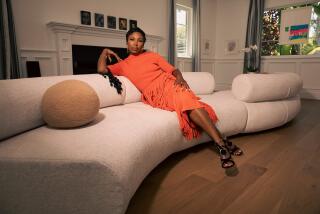A New You
- Share via
Has your social life descended to the depths of wearing pajamas and watching videos with a pal? Is your career as flat as last night’s leftover champagne?
This may just be the time to make some major changes: Reap a fatter paycheck, land a more stimulating career, attain a higher number on the social scale and create a new look for the new year.
“There’s a direct correlation between beauty and the bucks,” said Dianna Pfaff-Martin, founder of California Image Advisors in Newport Beach.
Quoting studies conducted by university psychology professors, she said: “Attractive people make more money.”
A first impression comes around only once, and people make 11 assumptions about you in the first minute--age, financial status, family background, education, trustworthiness, level of success, attention to detail, health, social status, self-confidence and tastefulness, according to studies cited by Pfaff-Martin.
Executive ladder-climbers are busy repackaging themselves with the help of image advisors.
Who are these practitioners of people packaging?
The Assn. of Image Consultants International grants the title of “professional image consultant” to members who complete a 20-page application and demonstrate proficiency in fashion, color theory, business practices and public speaking. Many consultants have experience in modeling, public relations and merchandising.
The 7-year-old group, based in Washington, D.C., has fewer than 100 members in the U.S., a third of whom are in California. They offer one-on-one consultations, group seminars and business briefings for corporate clients.
Brenda Kinsel of Image Consultants International reports that her average client is a woman between her late 30s and mid-50s. Over the course of a year, a client invest about 30 hours or $3,000 on Kinsel’s services.
“You need to look like your resume,” said the Bay Area consultant. “A major tool for living in this world is being as confident about yourself as possible.”
That’s not a new concept. What has changed in this final decade of the millennium?
Experts agree that those who entered the work force in the 1950s and ‘60s hold fond memories of a time when brains and a willingness to work hard were the most important criteria. Some million-dollar deals were sealed with a handshake.
Competition began to heat up in the ‘70s as women entered the job market in droves.
The friendly handshake was replaced by piles of legal documents. The era of the gray flannel suit was dead, and the Dress for Success movement was born.
The faltering economy of the late ‘80s and early ‘90s didn’t help matters. Experienced employees and professionals were forced to deal with a leaner and meaner economy. Younger workers often faced frantic competition without so much as a meaningful dress code to help guide them. (As large corporations downsized, human resources personnel who had trained management employees were among the first to go, and budgets for consultants were cut.)
The workplace has become a war zone, and even a bright and shiny, brand-new MBA is not enough ammunition.
*
Enter the image consultant.
“Success is based on perception. You can have the most fabulous product or service, but if you don’t present yourself as a successful person, you’ll never make it,” Pfaff-Martin said. “Image consultants are much more than personal shoppers. We deal in the perception of others, and I package my client based on who that client will be dealing with in the business world.”
That package includes teaching clients three distinct kinds of communication: visual (wardrobe and appearance), verbal (addressing an audience) and nonverbal (gestures, posture).
Her clients learn how to select a wardrobe based on colors that project a specific message. A navy suit relates confidence and responsibility. A red dress communicates dynamic leadership. Other skills include positioning yourself in a crowded room to attract attention or emphasize importance. Learning how to end a sentence on a firm down-tone shows decisiveness.
“Make your visibility count,” Pfaff-Martin said. “Move away from the crowd so others can see your value.”
Richard Redmond, a 52-year-old Costa Mesa loan consultant, turned to Pfaff-Martin for advice. Applying his newfound knowledge about image-building, he recently traded in his old car for a black Corvette.
“It comes in handy for business lunches because it only seats two people. It gives me time alone with the real decision-maker, a chance to get my point across to the only person that really counts,” Redmond said.
Although Pfaff-Martin often conducts her business in company boardrooms, Carol Priestley, owner of Personal Image, works out of a boutique in a small Lake Forest mall.
“We don’t dress to impress; we dress to express something about ourselves,” Priestley said. “I’m like a stylist on a movie set who’s been given a character to build, the outer packaging that creates a certain image. We are visual learners and live in a visual environment, so that is a great way to make a change.”
Most who seek Priestley’s help are going through change in their lives, she said. Some are recent college graduates entering the job market. Others are middle-aged professionals undergoing a career change. Many of her clients have been recently married--or divorced and seeking new relationships.
“Things in our subconscious show up in the way we dress unless we become very aware of them,” she said, citing how a person’s self-confidence is reflected in their level of neatness, attention to detail and appropriateness. “I try to tailor what’s inside to the outside and just move it a little.”
*
Priestley, a former model, teaches her clients about self-expression and image enhancement through makeup, skin care, hairstyling and wardrobe. She also gives advice about body language techniques, manners and other social skills.
“Having a professional image makes a difference when I present myself to others,” said Catherine Dauphin, a 50ish advertising executive from Mission Viejo who is a Priestley client. “People treat you differently.”
Dauphin brought a blouse that she never wore to Priestly, who put it together with a vest and tie and “made a wonderful outfit,” Dauphin said. “If you start building a wardrobe, you’ll have fewer pieces--I own 60% less than I used to--but you’ll always have what you need. I always feel I look good because of the confidence I have.”
No time to shop?
Jessica Thume, owner of Elegant Images in Coto de Caza, will come to you.
She’ll critique the contents of your closet, medicine cabinet and makeup case, and even accompany you to your favorite department store.
“Everything and anything goes in California,” she said. “The warm climate seems to make everyone more casual. But sometimes the tolerance level pushes the envelope.”
Thume, a former merchandiser, is convinced that casual-dress Fridays have created problems for many office workers. Executives, accustomed to wearing traditional two-piece uniforms, have trouble relaxing their look while maintaining a professional image. Managers complain that younger workers start dressing for the weekend one day too early.
“Most businesses have no written dress code, and management is often intimidated about bringing up the subject,” Thume said. Some clients of image consultants have developed a dress code for themselves.
“I work with high-level executives representing everything from the entertainment industry to the courts,” said Lily Ishii, 30, a translator and interpreter in Irvine and a client of Pfaff-Martin’s. “I need to look like I belong to each [industry].”
Ishii boasts a client list that has grown fivefold since her training.
Could these movers and shakers have done this the old-fashioned way, with a little attention to detail, basic common sense and the help of a knowledgeable department store salesperson?
Maybe.
“In our high-tech society people have been forced to make decisions about others very quickly,” said Karen Jones, a Laguna Beach psychotherapist. “To manage new information we categorize people and use various visual cues to make decisions about intelligence and financial status.”
Her concern is that people will depend on an image that has been constructed, an image sometimes at conflict with the true self. As a psychologist, she tries to help people grow from the inside.
“This usually results in a vastly improved exterior,” she said. “I also worry about the importance our society places on youth, looks and money. We live in a microwave culture. We want everything now, now, now.”
Sociologists recognize society’s preoccupation with image, behavior and appearance.
“We have to be more than just knowledgeable,” said Myron Orleans, professor of sociology at Cal State Fullerton. “We have to appear knowledgeable.”
(BEGIN TEXT OF INFOBOX / INFOGRAPHIC)
Reflecting on Others
Immediate assumptions are made in these areas when others first meet you:
AGE
HEALTH
FINANCIAL STATUS
FAMILY BACKGROUND
EDUCATION
TRUSTWORTHINESS
LEVEL OF SUCCESS
ATTENTION TO DETAIL
SOCIAL STATUS
SELF-CONFIDENCE
TASTEFULNESS
Making Your Mark
Some signals that affect other’s perceptions:
Visual: Gestures, Posture, Wardrobe, Grooming
Verbal: Delivery, Manners
More to Read
Sign up for Essential California
The most important California stories and recommendations in your inbox every morning.
You may occasionally receive promotional content from the Los Angeles Times.










